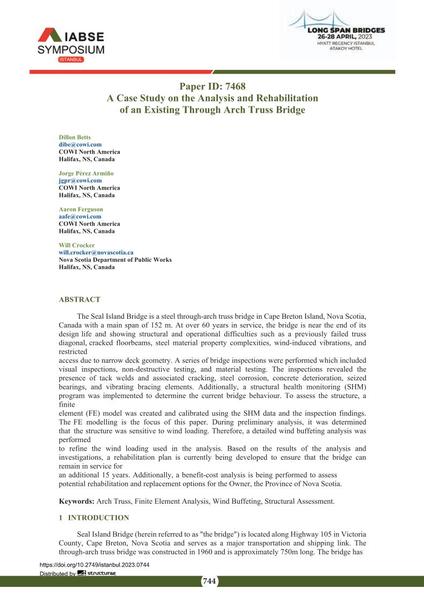A Case Study on the Analysis and Rehabilitation of an Existing Through Arch Truss Bridge

|
|
|||||||||||
Bibliografische Angaben
| Autor(en): |
Dillon Betts
(COWI North America Halifax, NS, Canada)
Jorge Pérez Armiño (COWI North America Halifax, NS, Canada) Aaron Ferguson (COWI North America Halifax, NS, Canada) Will Crocker (Nova Scotia Department of Public Works Halifax, NS, Canada) |
||||
|---|---|---|---|---|---|
| Medium: | Tagungsbeitrag | ||||
| Sprache(n): | Englisch | ||||
| Tagung: | IABSE Symposium: Long Span Bridges, Istanbul, Turkey, 26-28 April 2023 | ||||
| Veröffentlicht in: | IABSE Symposium Istanbul 2023 | ||||
|
|||||
| Seite(n): | 744-751 | ||||
| Anzahl der Seiten (im PDF): | 8 | ||||
| Jahr: | 2023 | ||||
| DOI: | 10.2749/istanbul.2023.0744 | ||||
| Abstrakt: |
The Seal Island Bridge is a steel through-arch truss bridge in Cape Breton Island, Nova Scotia, Canada with a main span of 152 m. At over 60 years in service, the bridge is near the end of its design life and showing structural and operational difficulties such as a previously failed truss diagonal, cracked floorbeams, steel material property complexities, wind-induced vibrations, and restricted access due to narrow deck geometry. A series of bridge inspections were performed which included visual inspections, non-destructive testing, and material testing. The inspections revealed the presence of tack welds and associated cracking, steel corrosion, concrete deterioration, seized bearings, and vibrating bracing elements. Additionally, a structural health monitoring (SHM) program was implemented to determine the current bridge behaviour. To assess the structure, a finite element (FE) model was created and calibrated using the SHM data and the inspection findings. The FE modelling is the focus of this paper. During preliminary analysis, it was determined that the structure was sensitive to wind loading. Therefore, a detailed wind buffeting analysis was performed to refine the wind loading used in the analysis. Based on the results of the analysis and investigations, a rehabilitation plan is currently being developed to ensure that the bridge can remain in service for an additional 15 years. Additionally, a benefit-cost analysis is being performed to assess potential rehabilitation and replacement options for the Owner, the Province of Nova Scotia. |
||||
| Stichwörter: |
Finite-Elemente-Analyse
|
||||
